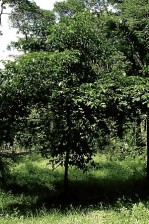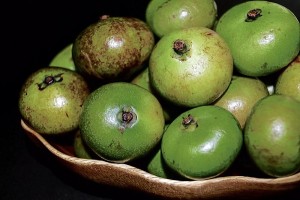Binukau
 As a young girl growing up in Negros Occidental, I munched on the small sour fruit of Batuan (aka Binukau, or Garcinia binucao) that abounded in the farm—the same fruit that our cooks would use to sour the broth of dishes such as sinigang, or the iconic Negros food called “KBL” (short for kadios-baboy-langka), a stew of pork, black pigeon peas and green jackfruit slices.
As a young girl growing up in Negros Occidental, I munched on the small sour fruit of Batuan (aka Binukau, or Garcinia binucao) that abounded in the farm—the same fruit that our cooks would use to sour the broth of dishes such as sinigang, or the iconic Negros food called “KBL” (short for kadios-baboy-langka), a stew of pork, black pigeon peas and green jackfruit slices.
Batuan leaves would also be stuffed into roast chicken and the ever so popular lechon (roasted whole pig) to give them a tinge of that delicate sour flavor we loved so much.
Us girls, however, would just wash the fruit, score them with salt and dig our teeth into their crunchy, fruity tartness. Today, it is still a constant feature on our dining table with a cup of guinamos on the side, whenever the fruit is in season.
Much later, when my husband and I started looking for more Batuan seedlings to plant in the farm, we had a hard time collecting the number of seedlings we needed, and we did not have much luck in germinating the seeds.
 It took years before our farm experts found a way to germinate Batuan seeds efficiently, allowing us to establish a small Batuan plantation. Now we have hundreds of Batuan trees and when the fruit is in season, we make it into bottled puree and jam so that it can be enjoyed anytime of the year, even by those who live faraway.
It took years before our farm experts found a way to germinate Batuan seeds efficiently, allowing us to establish a small Batuan plantation. Now we have hundreds of Batuan trees and when the fruit is in season, we make it into bottled puree and jam so that it can be enjoyed anytime of the year, even by those who live faraway.
The tree is a close relative of mangosteen. It is found all over the Philippines as well as in Vietnam. The Batuan, sometimes spelled batwan, has different names in different places. It may be called balikot (Ilocos Norte); bilukao (Rizal, Bataan, Batangas and Camarines); binukao (Laguna, Bataan, Batangas and Camarines); buragris (Camarines); kamangsi (Tayabas); kandis (Palawan); kamurai; kulilem (Cagayan); or maninila (Albay).
It must have been such a useful or popular tree to have been given names in many parts of the country. However, it seems to be more popular on the islands of Panay and Negros.
The renewed interest in our culinary traditions, native trees and reforestation is making the Batuan fruit more accessible to more people in more places. Chefs and cooking enthusiasts have taken a liking to the fruit and it will surely be an ingredient in many more inventive dishes in the near future. In the meantime, I will continue to eat the fresh fruit and have the piping hot sinigang of my childhood.




















